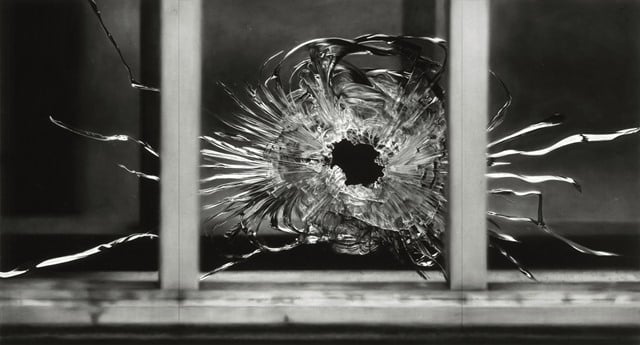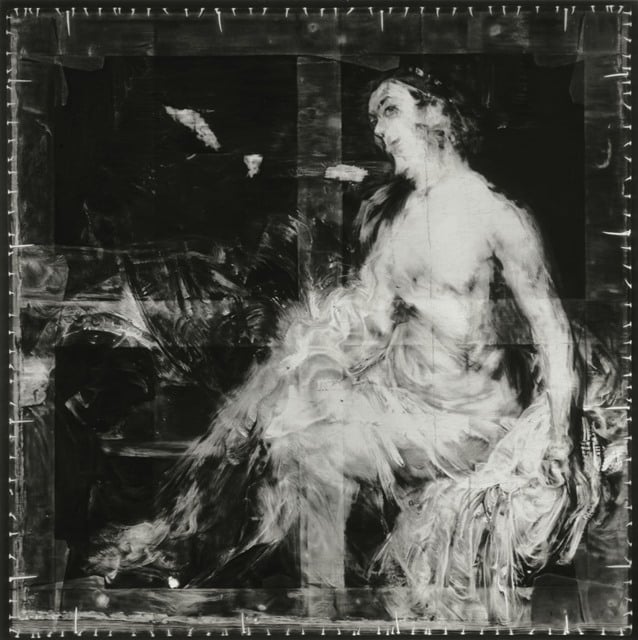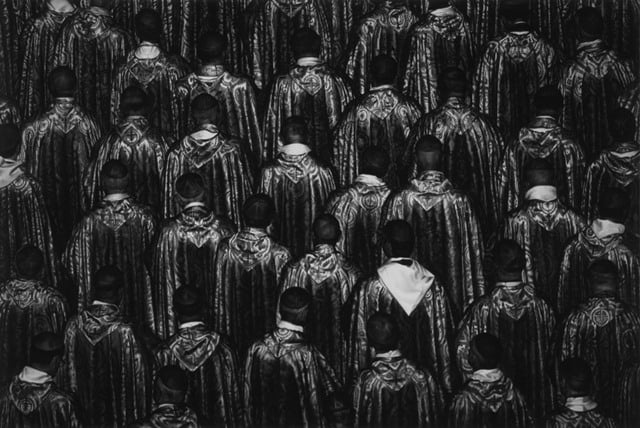Art & Exhibitions
Robert Longo Revisits ‘Charlie Hebdo’ Massacre in Daring New Paris Show
"My religion is art," Longo says.

Photo: courtesy Thaddaeus Ropac.
"My religion is art," Longo says.

Brian Boucher

A little more than a year after terrorists stormed the Paris headquarters of the satirical newspaper Charlie Hebdo, artist Robert Longo has unveiled a new work that confronts the violence and horror of that deadly attack. A massive drawing of a bullet hole in an office window greets visitors to “Luminous Discontent,” his new show at Paris’s Galerie Thaddaeus Ropac. Having lived for a time in the City of Light, as he told artnet News in a phone interview, he chose to take on some subjects specific to that city in the exhibition, which opened Saturday.
Despite skirting more graphic imagery, the drawing points to the brutality of the assault, where assailants used submachine guns to shatter the bulletproof glass that was installed after a previous attack.
This act is just one form of destructive power Longo considers in the new works on display. For instance, Untitled (Shipwreck, Redux), 2016, is a giant, abstracted charcoal drawing of Théodore Gericault’s The Raft of the Medusa (1818-1819), which acts as an indictment of official government negligence.
Neighboring the Hebdo bullet hole work are images of icebergs, which, in the artist’s mind, serve as another example of a “man-made disaster,” namely that of climate change.
Other parts of the show are a little more hopeful, like when Longo pays tribute to some artistic giants, including Samuel Beckett, Ludwig van Beethoven, Caspar David Friedrich, and Rembrandt van Rijn.
“The history of art is basically a ladder that we as artists are meant to step on to get a little higher and establish another rung in the ladder so someone else can step on us,” the artist told artnet News in a phone interview Thursday. “My religion is art and these are my saints.”

Robert Longo, Untitled (X-Ray of Bathsheba at Her Bath, 1654, After Rembrandt), 2015-2016.
Photo: Courtesy Galerie Thaddaeus Ropac, Paris/Salzburg.
Even failure can provide a point of light, he said.
“This show was in some ways torture for me because I tried to do things I’d never done before,” he said, especially since it’s more difficult for him to work after a recent stroke. The challenges artists face when pushing themselves, he said, connected him to writers like Beckett.
“Beckett asked Giacometti to help him make a tree for the set of Waiting for Godot, and they never felt they succeeded—here are these giants, and they couldn’t figure out how to make a fucking tree!” he said. “I found that inspirational.”
The play, a cornerstone for countless contemporary artists, links up with the moment we’re living through, he went on.
“That play mirrors where we are politically in so many ways—we’re waiting for the Republican convention!” Longo said. “The two characters who are waiting for Godot are like Trump and Cruz.”
“What scares me,” he added, “is that Godot could be Paul Ryan.”

Robert Longo, Untitled (Vatican Bishops), 2015-2016.
Photo: Courtesy Galerie Thaddaeus Ropac, Paris/Salzburg.
The show spans the gallery’s three levels. On the top floor is heaven, where those artistic “saints” reside, in the form of drawings based on X-rays of works by art-historical giants like Rembrandt. On Earth are the Hebdo and Gericault drawings, among other works, and on the lowest level hangs a sinister drawing of dozens of Vatican bishops, viewed from behind. The work finds a parallel with Longo’s earlier, massive drawing of the US Capitol, a site of power that is also a locus of corruption.
“I definitely believe in a higher power,” he said, “because I think there has to be something higher than one’s ego in this world.”
Robert Longo’s exhibition “Luminous Discontent” is on view at Galerie Thaddaeus Ropac’s Marais location, in Paris, through May 22.